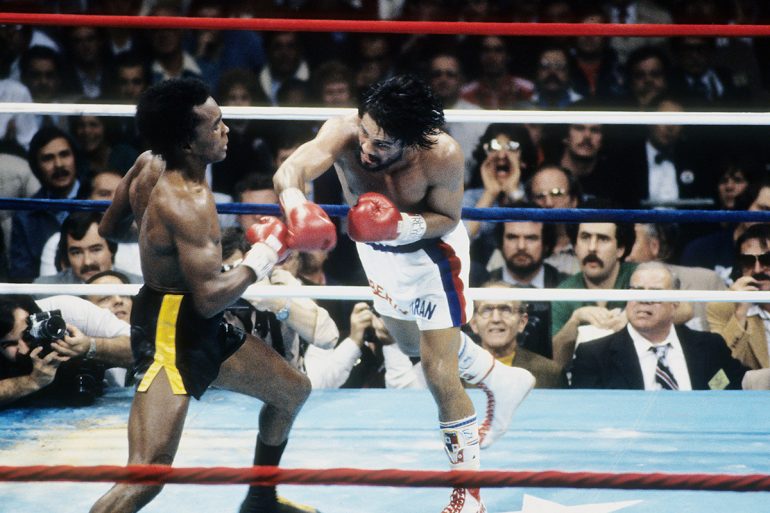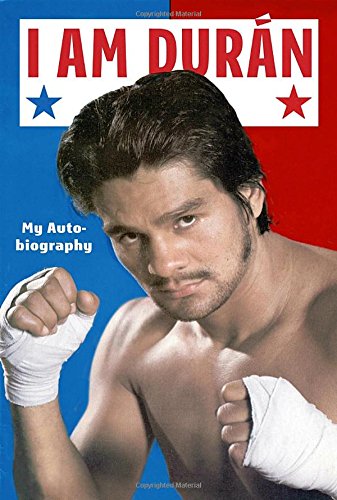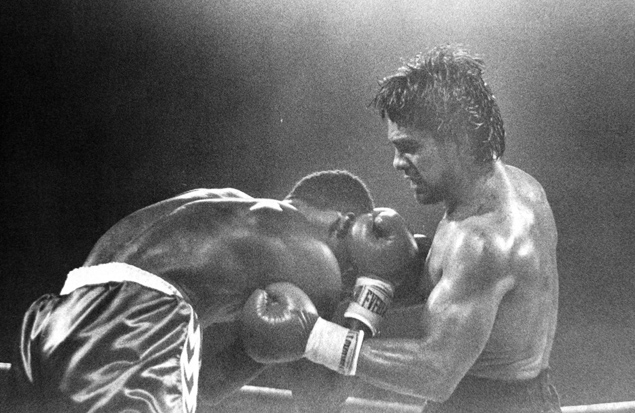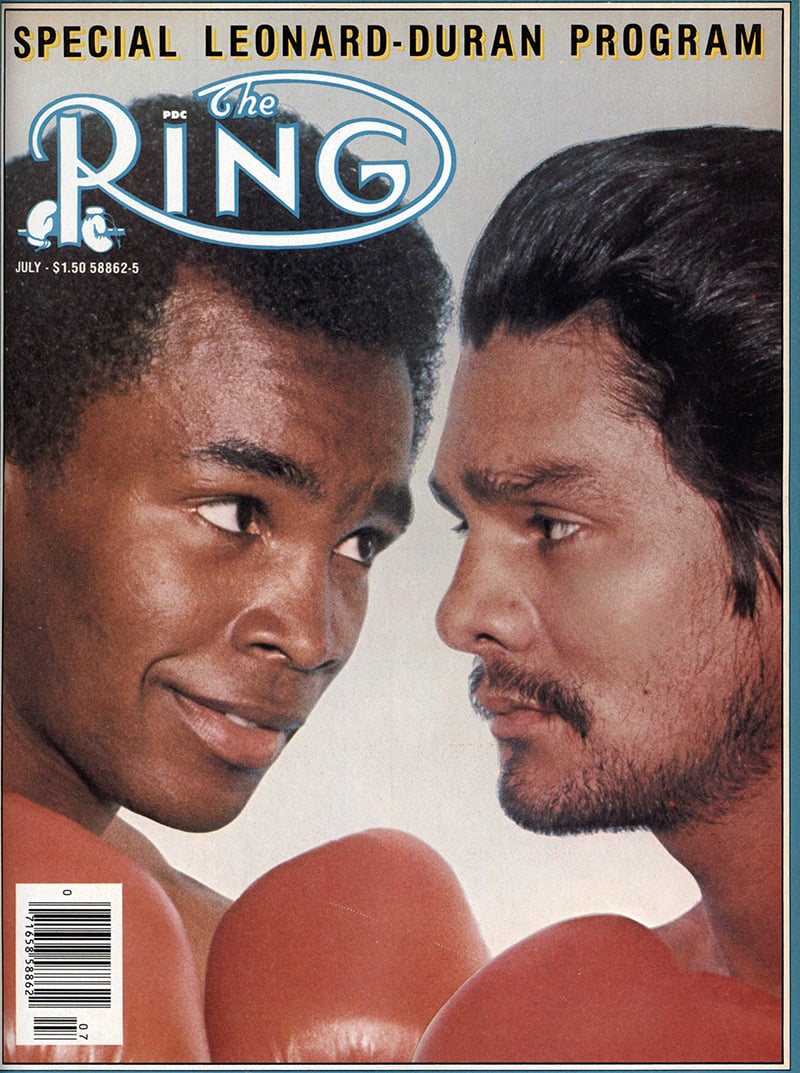Literary Notes: ‘I Am Duran’

Roberto Duran had an epic career and is widely regarded as one of the greatest fighters who ever lived. His first pro fight was contested on February 23, 1968, when he was 16 years old; his last, on July 14, 2001, when he was 50. He fought during the terms of eight presidents of the United States.
At one point, Duran’s ring record stood at 72 wins against a single loss. He won championships in four weight divisions and was part of a fistic round-robin with Ray Leonard, Marvin Hagler and Thomas Hearns that electrified boxing fans in the 1980s. His final ledger consists of 103 victories in 119 fights with 70 knockouts. One can fantasize that, but for a near-fatal car accident suffered on October 4, 2001, he might still be fighting.
 Duran is now a warm, almost cuddly presence on the boxing scene. He’s often in the media center before big fights, having been brought in by the promotion to tap into the Hispanic market. As recounted in “I Am Duran,” told by Duran to George Diaz (Blue Rider Press), it wasn’t always that way.
Duran is now a warm, almost cuddly presence on the boxing scene. He’s often in the media center before big fights, having been brought in by the promotion to tap into the Hispanic market. As recounted in “I Am Duran,” told by Duran to George Diaz (Blue Rider Press), it wasn’t always that way.
Duran’s mother was Panamanian. His father, Margarito Duran, was an American soldier of Mexican and Cherokee descent who impregnated Clara Samaniego while serving with the U.S. military in the Canal Zone.
“He made me and then left when I was one-and-a-half,” Duran recounts. “I wouldn’t see him for another twenty years. He was nothing to me. All he did was make me, see me, and then leave me.”
Roberto’s mother already had a son and daughter from two previous relationships when Roberto was born.
“Life wasn’t easy, but she didn’t make it any easier for herself or us,” Duran recalls. “I’m a child of the streets. My neighbors were thieves, whores, and murderers. I never made it past third grade. I know what poverty is because my childhood sucked. But I survived. Boxing champions never come from rich neighborhoods. They come from the barrios, the gutter. It’s God’s law.”
Duran fought with a combination of skill and savagery that was rare in any era. On March 2, 1975, he successfully defended his lightweight title with a 14th-round knockout of Ray Lampkin, who was hospitalized after the bout. “Today, I sent him to the hospital,” Duran told the media. “Next time, I’ll put him in the morgue.” After brutalizing Davey Moore in 1983 to claim the WBA 154-pound crown, Duran surveyed Moore’s battered swollen face and told him, “The next time, I’ll kill you. You’ll feel better.”
“I was a fighter,” Duran says. “I was paid to fight. That’s who I was and what I did. In a lot of ways, I was Mike Tyson before Mike Tyson came along. Fighters would take one look at me and crap in their pants.”
Duran’s greatest triumph was a June 20, 1980, decision over then-unbeaten Sugar Ray Leonard to claim the 147-pound crown. Looking back on his state of mind prior to that bout, Roberto says, “Some fast little black kid from the United States wasn’t going to beat me.”

Roberto Duran vs. Davey Moore
In the weeks and months after Leonard-Duran I, Duran, in his words, “went out drinking, dining, and partying. Night after night, we partied until everything was just one big haze. I got to the point where I weighed nearly two hundred pounds. What was I supposed to do after beating Leonard? Stay at home, go to church every day, not screw around and not drink? That’s not who I am.”
Then circumstances – including the incentive of an $8 million payday – forced Duran into a rematch against Leonard on short notice. He had less than two months to get into fighting shape and lose 50 pounds.
“I wasn’t feeling well,” Duran says of the days leading up to the November 25, 1980, rematch. “I spent almost every day in the sauna. I went two days without eating. When I stepped on the scale [to weigh in on the day of the fight], I was weak. I could feel nothing in my legs. I was nowhere near the fighter I’d been just months earlier.”
After the weigh-in, Duran ate ravenously, including two steaks washed down by orange juice, coffee, and cold water. Soon after, his stomach began to hurt. That night, with both fighters in the ring, Ray Charles sang “America the Beautiful” before the bout.
“Leonard thought he’d psyched me out,” Duran says. “But I wasn’t intimidated by him or the blind guy singing the American’s song. I just didn’t feel good. My stomach trouble had been getting worse. In the eighth, we had an exchange against the ropes. But by then, I had had enough. My arms were weak. My body was weak. I couldn’t move, couldn’t breathe properly. I backed off and waved with my right hand. Leonard hit me a few times, but I kept motioning to the referee that I didn’t want to fight. I never said ‘no mas.’ I just turned my back and motioned to the referee that I didn’t want to continue. When the referee asked me what I was doing, all I said was ‘no sigo [I do not follow].” I couldn’t go on. I couldn’t keep fighting. I felt like crap. But I never said ‘no mas.’”

“I’m a proud man,” Duran continues, “but also an impulsive one. Sometimes I make a bad decision and, in due course, think ‘Oh, s—.’ This was the biggest ‘Oh, s—’ moment of my life. But it was too late. I let my emotions get the better of me. I didn’t know the world would react the way it did, and I didn’t know I would get treated like s— for so long. I didn’t know it would haunt me for the rest of my life. ‘No mas.’ It started then and it went on for years. Even now, thirty-six years later, people still bring up that ‘no mas’ s—. F— ‘no mas.’ I’m sick of hearing it.”
“I Am Duran” has few if any new insights into boxing or Duran’s magnificent ring career. But there are quite a few personal nuggets.
On Duran’s first date with his future wife, Felicidad, he took her to a movie about killer rats.
Duran is also candid in the book about the lifestyle issues that have been tabloid fodder over the decades.There are accounts of debauchery, including a drunken threesome that Roberto engaged in with two women during the interval between the Hagler-Duran and Hearns-Duran fights.
“I’m a family man who loves his wife,” Duran says. “But I’ve also slept around and fathered other children. I make no apologies for that. As world champion, as one of the most famous and honored men in Panama, I’ve been around temptation every day, and I’m not going to say sorry for the things I’ve done. I have three other children with three other women. These things happen. I’m just a man. Some people may look down on the way my life has turned out. But everyone in Panama knows my family situation, and I don’t care what people think.”
The other side of that coin was revealed when Duran’s daughters started dating.
“I didn’t mind them having boyfriends,” Roberto acknowledges. “But if those boys stepped out of line with my girls, I threatened to kill their entire families. I think they understood what I was saying. We didn’t have a lot of problems after talks like that.”
After Duran (who is 5-feet-7-inches tall) retired from boxing, his weight ballooned to 260 pounds. Doctors told him that his obesity was life-threatening. That led to the decision to undergo surgery, although “I Am Duran” is unclear on whether Roberto opted for gastric bypass surgery or the insertion of a gastric band. Both procedures are referenced in the book.
Meanwhile, throughout Duran’s career, whatever money wasn’t siphoned off before it reached his hands was quickly spent.
“People think I’m a millionaire,” Duran says. “I used to be. I made about $60 million from my fights. But nowadays, the house is all that’s left to show for it. The cash I do have goes to paying the bills for food, water, and electricity with a little bit put aside in case of emergency. The days of buying fancy cars are long gone. It’s been years since I had a payout from a fight. And Panama being the place it is, I’ve had money problems.”
Still, “I Am Duran” ends on an upbeat note.
“Look at the legacy,” Duran urges in closing. “There were the Four Kings: Duran, Leonard, Hagler, and Hearns. We gave boxing fans everything and more when we fought each other. We were all stars and we all wanted to beat the s— out of each other. We shook hands and then we fought. We hated each other’s guts. And now we smile, pose for pictures, and have a drink together every so often. That’s boxing.”
Thomas Hauser can be reached by email at [email protected]. His most recent book – “A Hard World: An Inside Look at Another Year in Boxing” – was published recently by the University of Arkansas Press. In 2004, the Boxing Writers Association of America honored Hauser with the Nat Fleischer Award for career excellence in boxing journalism.















